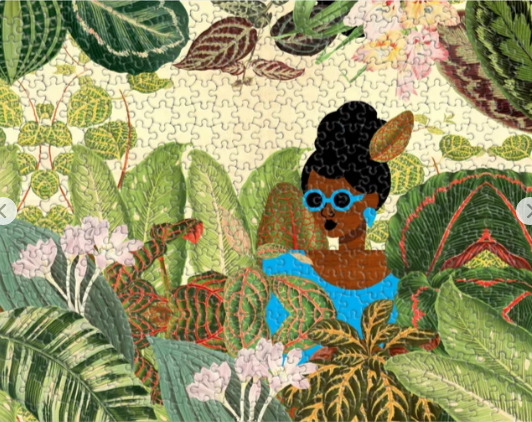In my article A Guide to Diversifying Revenue and generating more passive income for Artists, I referred to Art Licensing and in today’s article, I made sure I cover every detail and question that may come to mind when talking about art licensing.
What is Art Licensing?
Art licensing refers to the process of giving permission to use an artist’s artwork for commercial purposes. It is a legal agreement between the artist and a manufacturer or retailer, which allows the latter to reproduce and distribute the artist’s work on their products. In exchange for the right to use the artwork, the artist typically receives a percentage of the sales revenue or a flat fee.
Why is Art Licensing good for artists?
Art licensing provides a new source of income and exposure for the artist’s work, as well as potentially expanding their audience. For the buyer, it can add value and appeal to their products, as well as provide them with unique and attractive designs that they may not have otherwise had access to.
Are you eligible for art licensing?
Art licensing is open to any artist or designer who owns the copyright to their work and is interested in licensing their art for commercial use. This can include both established and emerging artists, as well as designers who create patterns, illustrations, or other types of visual content.
Artists who specialize in certain styles or subjects may be particularly well-suited for art licensing. For example, artists who create children’s illustrations, or abstract patterns may be in high demand by manufacturers who produce products in those categories.
Is all Art suitable for Art Licensing?
However, it’s important to note that not all artwork is suitable for licensing. Art that is too niche or too personal may have limited appeal to a broad audience, while artwork that is too complex or difficult to reproduce may not be practical for use on consumer products. Additionally, artists should ensure that they have the legal right to license their work, including obtaining any necessary permissions or releases for copyrighted materials or recognizable individuals depicted in their art.
Ultimately, if you are interested in art licensing, I recommend you research the market, understand your own unique selling points, and be prepared to invest time and effort in marketing your work to potential licensees.
How to claim your artwork’s copyright?
As the creator of original artwork, you automatically own the copyright to your work as soon as you create it. However, it’s always a good idea to take additional steps to ensure that your rights are protected and to make it easier to enforce them in case of infringement. Here are the steps you can take to claim your artwork’s copyright:
- Add a copyright notice: A copyright notice is a statement that identifies you as the owner of the copyright and indicates the year of first publication. The notice typically includes the copyright symbol (©), your name, and the year the work was created. For example: © [Your Name], [Year of Creation]. This notice should be displayed prominently on your artwork or on the packaging if it’s a physical product.
- Register your copyright: Registering your copyright with the relevant government agency provides additional legal protection and makes it easier to enforce your rights in case of infringement. In the United States, you can register your copyright with the U.S. Copyright Office. Other countries have similar agencies that handle copyright registration.
- Keep records: Keep records of the creation of your artwork, such as sketches, drafts, and photographs. These records can be used as evidence of your ownership and can help you prove that your work is original in case of disputes.
- License your work: If you want to allow others to use your artwork while retaining your copyright, you can license your work. This allows you to set conditions for the use of your work and to receive compensation for its use.
It’s important to note that copyright laws vary from country to country, so it’s a good idea to consult with a legal professional who specializes in copyright law in your jurisdiction.
How to find art licensing deals as an artist?
Finding art licensing deals can be a challenging process, but there are several strategies that artists can use to increase their chances of success. Here are some tips:
- Research potential licensees: Start by researching companies that produce products that would be a good fit for your artwork. Look for companies that have a history of licensing art, as well as those that produce products that align with your style and subject matter. POD platforms are a great example.
- Attend trade shows: Attend trade shows such as Surtex, Licensing Expo, or Printsource to network with potential licensees, showcase your work, and get a sense of what’s trending in the industry.
- Build relationships: Connect with potential licensees through social media, email, or phone and start building relationships with them. Share your portfolio, inquire about their needs, and stay in touch regularly.
- Use art licensing agencies: Consider working with an art licensing agency, which can help match your work with potential licensees, negotiate contracts, and handle administrative tasks.
- Build your online presence: Create a professional website, blog, or social media presence that showcases your work, describes your licensing services, and provides contact information.
- Attend workshops: Attend workshops or classes on art licensing to gain knowledge and insights on the industry and how to market your work effectively.
Overall, finding art licensing deals requires a combination of creativity, persistence, and networking. By putting in the effort and using multiple strategies, you can increase your chances of success in the competitive world of art licensing.
Companies that do art licensing with emerging artists
There are several companies that do art licensing with emerging artists. Here are a few:
- Artlyst: Artlyst is an online art marketplace that connects emerging artists with buyers and collectors. They also offer licensing opportunities for artists to showcase their work on products such as phone cases, tote bags, and home decor items.
- Creative Action Network: Creative Action Network partners with artists to create artwork that raises awareness for social and environmental causes. They license these designs for use on various products, such as apparel, home decor, and accessories.
- The Art File: The Art File is a UK-based company that specializes in designing and producing greeting cards, stationery, and gift wrap. They work with a range of artists, including emerging talent, to create unique designs for their products.
- Wild Apple: Wild Apple is a design and licensing company that works with a variety of artists, including emerging talent, to create artwork for use on products such as home decor, textiles, and stationery.
- Bright Art Licensing: Bright Art Licensing represents a diverse group of emerging artists and illustrators from around the world. They license their artwork to publishers, manufacturers, and retailers for use on various products, such as children’s books, toys, and home decor items.
These are just a few examples of companies that work with emerging artists for art licensing. As an emerging artist, it’s important to research and evaluate different companies to find the best fit for your needs and goals.
Conclusion
Feel free to leave me your questions in the comment section or share with me other platforms for more art licensing deals. Enjoy creating <3




I have a one of a kind God’s Artwork in my life and I am looking forward to licensing her to me alone always and forever. Could you help me with that ?
Haha I don’t know much about that kinda licensing but will do my research and get back to you
Hi KHAOULA, excellent article! I recently contacted an artist about using a piece she recently created for my bands new album; if she doesn’t have an amount for the licensing fee (we’re not an established band, and I don’t think she does her art as more than a sideline) is it proper for me to offer/suggest an amount for usage? I fully intend on promoting her as much as she would desire, and listing her copyrights to the work. This is all new to me, so any information is appreciated…
Hey Gary, Thank you for your reading time! Before I share my opinion on this, may I ask you if you have a written contract for the use of her art for your album? If not, offering her a flat fee for licensing would be a great thing to prevent any future troubles! She then can decide if she’s selling the licensing copyright free or would want you to promote the work as hers and mention the copyrights. Feel free to leave me any other question for further info
Would you be willing to share a percentage of your album sales with the artist in exchange for licensing their work, or do you believe a flat fee is a fairer arrangement?
Hey Jeff! great question. I definitely think that a percentage is fairer than a flat fee. However, in some cases, securing a flat fee is so much better for the artists willing to keep on developing their style and making money along the way.